Tarragon Isn’t Always The Easiest Herb To Grow, But Works Well In The Right Conditions

HERBS > TARRAGON

Elizabeth is a Permaculture Garden Designer, Sustainability Consultant and Professional Writer, working as an advocate for positive change. She graduated from the University of St. Andrews with an MA in English and Philosophy and obtained a Diploma in Applied Permaculture Design from the Permaculture Association.
Reviewed By COLIN SKELLY

Colin is a Horticulturist and Horticultural Consultant with experience in a range of practical and managerial roles across heritage, commercial and public horticulture. He holds the Royal Horticultural Society’s Master of Horticulture award and has a particular interest in horticultural ecology and naturalistic planting for habitat and climate resilience.
IN THIS GUIDE
TARRAGON GUIDES
Tarragon is a useful culinary herb to grow in your garden or indoors.
It is not always the easiest herb to grow here in the UK, but this simple guide should help you understand it better – and to make the right choices and care for it in the right way if you want to grow it at home.
Overview
| Botanical Name | Artemisia dracunculus var. sativa |
| Common Name(s) | French Tarragon, Russian Tarragon |
| Plant Type | Perennial Herb |
| Native Area | Mediterranean |
| Hardiness Rating | H6 |
| Foliage | Deciduous |
| Flowers | Pale yellow |
| When To Sow / Plant Out | April, May, June, July, August |
| Harvesting Months | June, July, August, September |
Sunlight
Preferred
Full Sun
Exposure
Sheltered
Size
Height
0.5 – 1M
Spread
0.1 – 0.5M
Bloom Time
June – August
Soil
Preferred
Loam, sand
Moisture
Well-drained
pH
Any
There are two main types of culinary tarragon, informally known as French tarragon and Russian tarragon.
French Tarragon

A. dracunculus var. sativa, is a common culinary herb.
French tarragon is considered to be the superior herb for kitchen use and it is one of the fines herbes of French cuisine.
Russian Tarragon
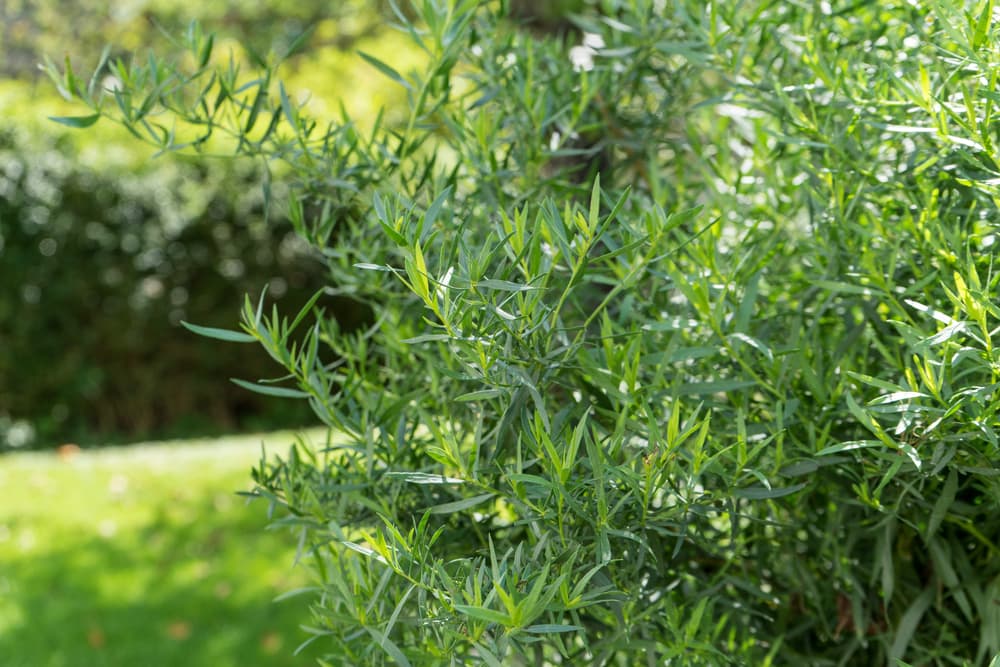
Sometimes considered a variant of A. dracunculus – botanically named A. dracunculoides – is considered to be weaker in flavour, but is better equipped to survive colder temperatures and tends to grow more vigorously.
It spreads at the roots, thrives on neglect, and copes with poor soils and even drought.
While not great as a culinary herb, Russian tarragon does have a range of other uses and is sometimes grown where French tarragon will not thrive.
In the UK, French tarragon is usually the variety recommended for cultivation.
This is a short-lived perennial herb which, though it will usually only continue producing for a few years, can be propagated for a continued supply.
Why Grow Tarragon?
Growing tarragon, especially French Tarragon, is a great choice for those who love cooking with their own homegrown produce and herbs.
The aromatic leaves have a lovely liquorice or anise-like flavour and can be used fresh or dried for later use.1Tarragon. (2018, December 17). FoodPrint. Retrieved March 24, 2023, from https://foodprint.org/real-food/tarragon/

Additionally, tarragon is notable for its ability to attract beneficial wildlife to the garden.
It is also said to aid in repelling certain pest species as well as sheltering beneficial insects.
How To Grow Tarragon
Tarragon needs a warm, dry and sunny position, with well-drained neutral or slightly alkaline soil.
It is most frequently grown in a dedicated herb garden alongside other Mediterranean herbs which enjoy the same or similar growing conditions like rosemary, lavender, marjoram, oregano, thyme etc.

However, it may also be beneficial to consider placing tarragon (either in the ground or in containers) around the crops you are growing in your kitchen garden for beneficial wildlife attraction and organic pest control.
Companion Planting
Like other aromatic herbs, tarragon makes a great companion plant for a range of garden crops and other plants.
Anecdotally, some have also traditionally believed it to enhance the growth and flavour of other crops grown close by – so you may also wish to consider growing tarragon in pots close to annual vegetable areas, or placing tarragon around the edges of annual beds.
Tarragon is said to be a particularly beneficial companion plant for aubergines and peppers, though it could aid a range of other plants too.
Growing From Seed
French tarragon is a perennial herb that does not flower or set seed reliably, meaning it is not usually grown from seed.
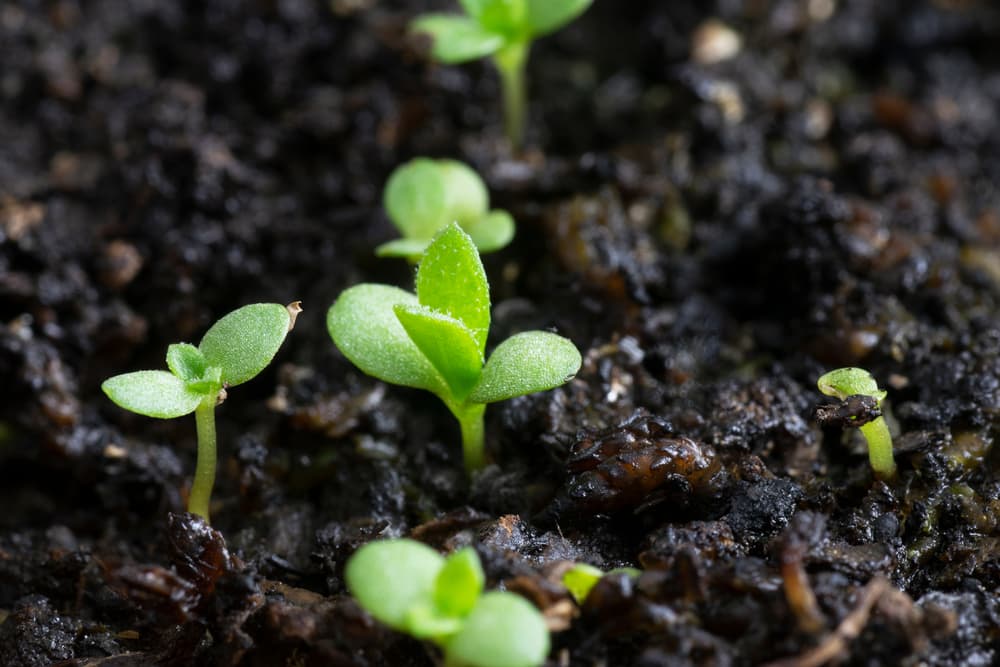
When seed for tarragon is sold, this is usually the inferior form of Russian tarragon.
If you wish to grow French tarragon, you will usually purchase pot-grown plants in spring.
These tarragon plants are usually potted up into larger pots filled with a free-draining growing medium, or they are planted out into free-draining garden soil in a sunny, sheltered spot.
Planting Tarragon
If you are growing tarragon in a pot, choose a container which allows for dry and free-draining conditions as the plants are said to taste better when not grown in moist conditions, in relatively poor soil.
A terracotta pot is ideal for growing herbs which prefer drier and more free-draining conditions.
Fill your container with a peat-free multi-purpose compost with plenty of horticultural grit.
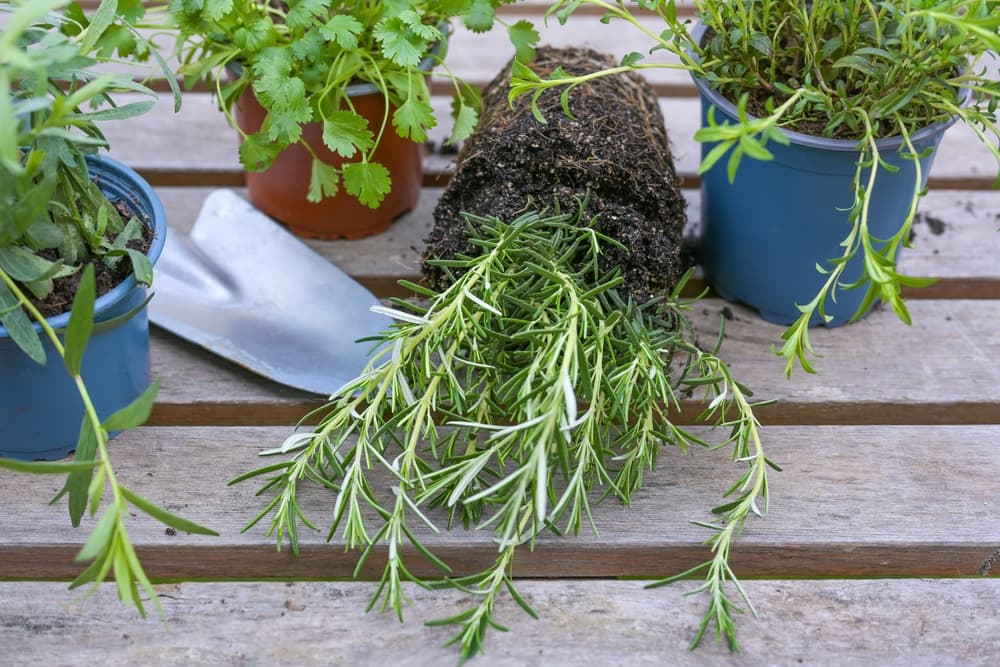
Make sure you place a crock at the base – and use a pot stand – to ensure that water can always drain away freely.
Plant the tarragon to the same depth in this container as it was in its previous one.
If you are planting tarragon out in your garden, be sure to choose a site where water drains freely, and where the tarragon will get as much warmth and sun as possible.
Make sure that you avoid frost pockets, and any areas which become waterlogged – tarragon roots will rot in wet or heavy soils.
Plant out in spring as soon as the weather has warmed reliably and frosts are well passed.
Tarragon Plant Care
French tarragon is not as easy as some other perennial herbs to grow.
While it can be very tolerant of poor soils and free drainage, it can be fussy about other conditions and it is important to care for your plants correctly if you want to see the best results.
Watering
Though tarragon likes free-draining conditions, it is important not to let the growing medium dry out entirely, especially when you are growing tarragon in pots.
Young plants, and plants grown in containers, will require more frequent watering than mature specimens and those growing in the ground.
Make sure that you water regularly throughout the growing season, but do not overwater.
Try also to ensure that plants do not stand in water during heavy rains, or suffer excessive watering, as this can cause the roots to rot.
Pruning & Harvesting

You can pick the leaves of tarragon any time throughout the growing season.
The leaves will continue to come as long as the plant does not flower.
It is good practice to cut back or harvest around half of your plants in around June for a continuous harvest.
If you see flower buds emerging, you should nip these out so that the plants continue to produce their leaves.
Pests & Problems
Tarragon can be very popular with slugs, especially early in the season and when plants are young and small.
Remain vigilant as you may lose entire plants to these pests if you do not catch them early.
Pick slugs by hand to remove them, use physical barriers, and remember that the best way to control slugs in an organic garden is to entice plenty of their predators to your garden to keep their numbers down.
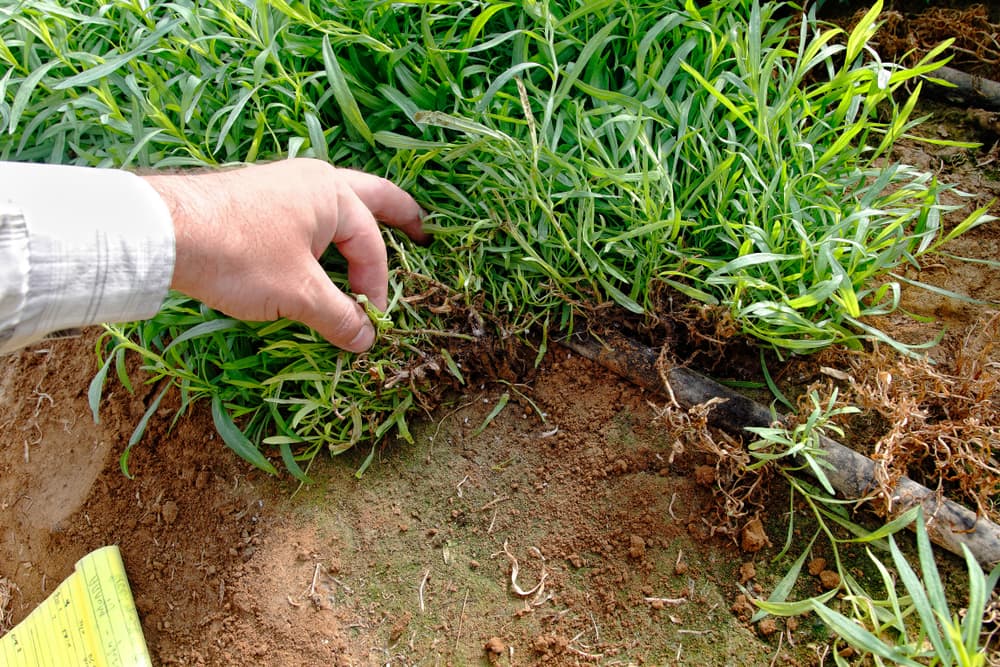
Tarragon can also be susceptible to fungal infections like powdery mildew and rust.
Avoid overcrowding, ensure adequate drainage, make sure you are watering correctly, and grow in cooler conditions to reduce the chances of these problems taking hold.
Remove and carefully dispose of any affected plant material as quickly as possible.
Winter Care
French tarragon is borderline hardy, so will need to be in a sheltered position over the winter months, or moved under cover in colder areas.
In colder areas, you can also consider protecting the plant with a cloche or horticultural fleece.
The above-ground growth will die back each autumn, but new growth should emerge in the spring as long as the roots remained healthy over the winter months.
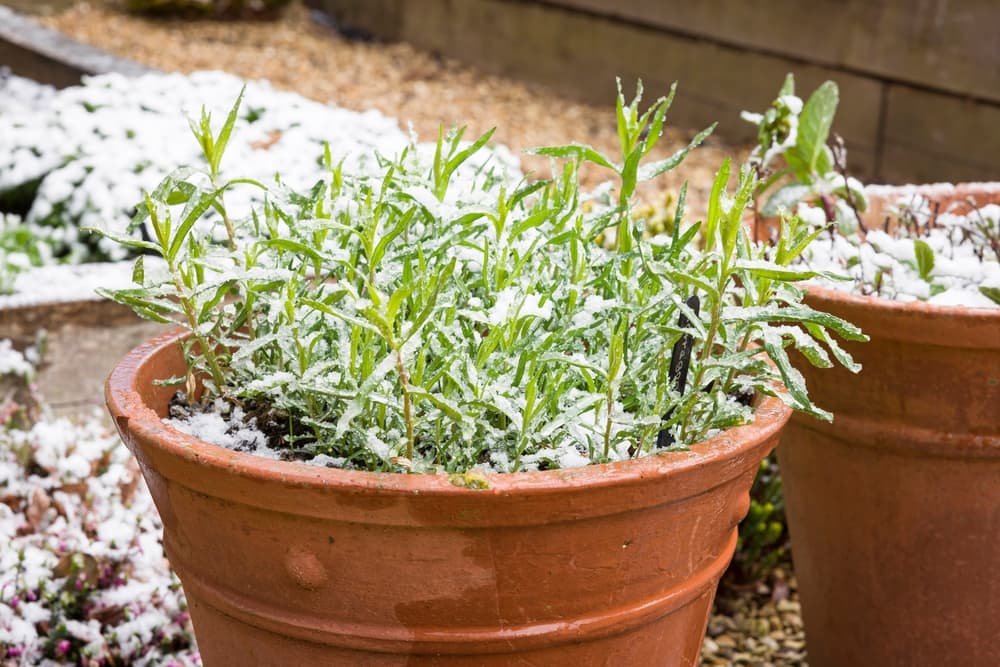
Waterlogging rather than temperature is usually the main issue, so it is often a good idea to move the tarragon to an unheated greenhouse or cool porch, for example, over the coldest and wettest part of the year.
“French Tarragon will not survive the winter wet in my garden,” says Master Horticulturist Colin Skelly.
“I grow it in a pot and keep it in a cold greenhouse over winter, making sure to water very minimally whilst it is not in active growth.”
Placing pots in the rain shadow of a wall or fence may also help.
Propagating By Division
French tarragon, as mentioned above, cannot usually be reliably propagated by seed – but once you have a tarragon plant, you can still increase your plant stock and ensure an ongoing supply of this useful herb by taking root divisions of mature plants.
Remember, though tarragon is a perennial plant, it will run out of steam after a few years.
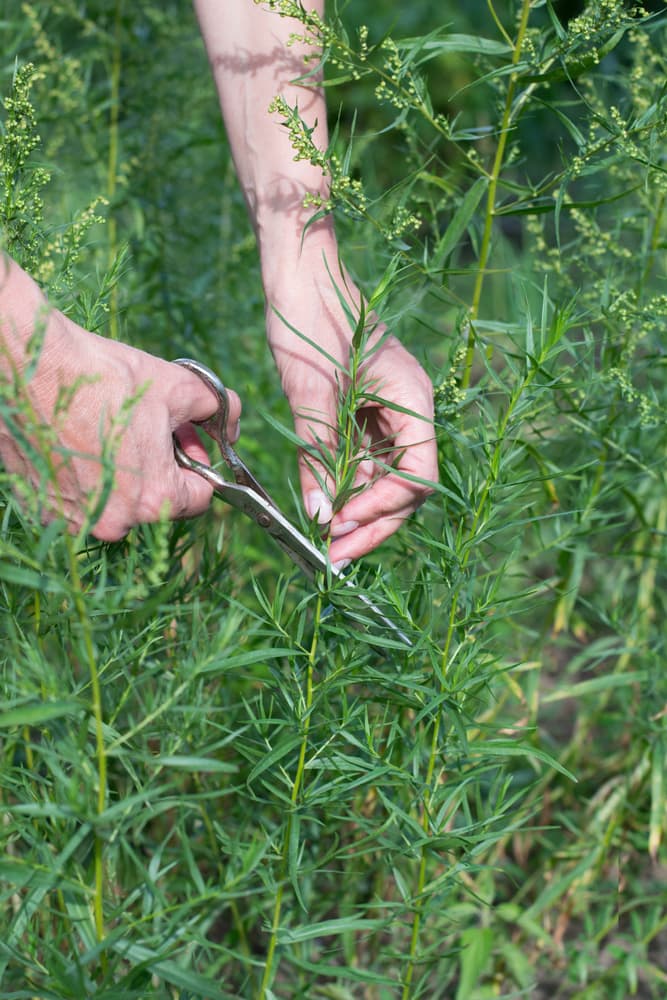
Taking divisions is a good way to make sure you have new plants to replace the older ones.
- In autumn, take a mature, large tarragon plant in a pot.
- Remove the plant from its pot and saw the root ball in half.
- Repot one half, using fresh, peat-free multipurpose compost and grit, then divide the remaining half into a number of root cuttings.
- Cut off the top growth from your root cuttings, and prune off thin straggly roots so that each cutting can fit into a module or small pot.
- Take care not to do any damage to the main creeping rhizome which stores the energy for next year’s crop.
- Then pot up these root cuttings and water lightly.
- Label them, then place them in an unheated greenhouse, polytunnel or cold frame over winter before planting out the following spring.
Tarragon is not always the easiest herb to grow in the UK, but it is worth it for those gourmands who want to grow all the fresh ingredients needed for their culinary creations in their own garden.
References
- 1Tarragon. (2018, December 17). FoodPrint. Retrieved March 24, 2023, from https://foodprint.org/real-food/tarragon/
